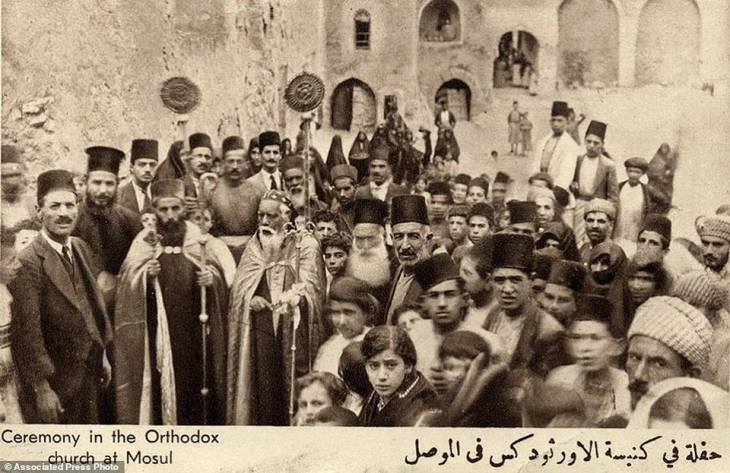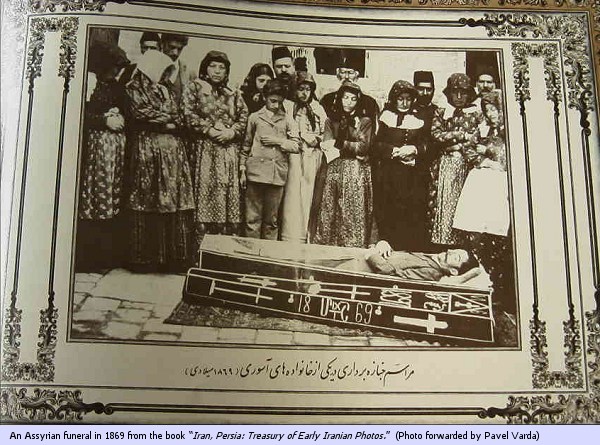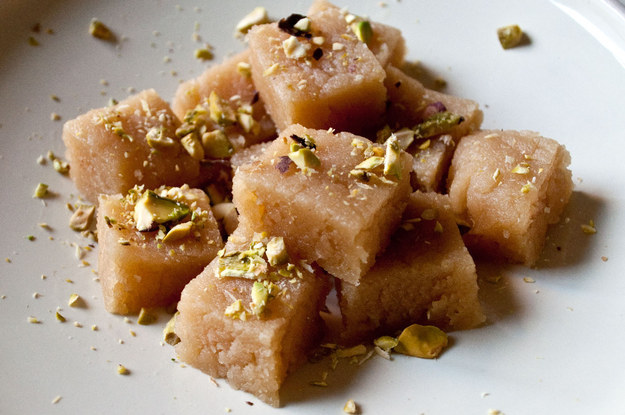Featured photo: the Assyrian Genocide Memorial in Chicago, IL. Source: http://www.atour.com/history/landmarks/20130731a.html.
Who are the Assyrians?
The Assyrians are descended from an ancient Semitic people, who comprised one of the oldest civilizations in the world. Now, in the Middle East, they are a Christian minority. The Assyrians are a people who have had to survive trauma repeatedly throughout history, stemming from relentless persecution by non-Christians. The Assyrian Genocide, wrought by the Ottoman Empire, was a “program of extermination.” It lasted from approximately 1914-1920, and occurred in conjunction with the Armenian and Pontic Greek Genocides, where “close to three million Christians of Syriac, Armenian or Greek Orthodox [were] slaughtered by the Young Turks” (Nash). The United States government does not formally recognize these genocides.
Now the Assyrian people face persecution in Iraq, Iran, Turkey, and Syria. They have seen their historic sites and places of worship demolished by ISIS.

“I think the reason burials have such distinct customs in Assyrian culture is because of how often death occurs,” says Nardin Sarkis, who is a student at the University of California, Santa Barbara and an Assyrian-American. “The last few centuries have been devastatingly brutal to Assyrians in their indigenous homelands.”
Nardin was kind enough to give me some insight into his culture’s mourning rituals and burial practices. “There are a lot of them given our frequent state of mourning. Aside from wedding customs, Assyrian burial customs are probably the most strictly followed and intricate series of traditions that continue in my community today.”
reesha basamta – “the healing of the head”
When an Assyrian community member passes, the days leading up to the funeral are called “reesha basamta” which translates literally to “the healing of the head.”In these days, the mourning household hosts guests open house style, and loved ones come visit the family to “heal their head” (meaning to offer condolences). At the house only bitter coffee and tea are served with no sugar, representing the state of the household. Some symbolically will not drink the coffee in front of them at all.
Using bitter food is a powerful, tangible way to symbolize the bitterness of grief. A similar practice is used in Switzerland, where male mourners place lemon rinds on the grave after the funeral service to “symbolize the ‘sharpness’ of their grief” (Troop).
The Assyrian Funeral
On the day of the funeral, there is a service held in church, followed by the burial at the cemetery. At the graveyard, Assyrians burn incense around the grave as clergy chant hymns in aramaic. The wife or closest female relatives traditionally wail and scream as the casket is lowered in a public display of grief. Everyone is expected to dress in complete black.

A tradition of wailing is important in many cultures because it lets the dead know they are loved and missed. This practice can be found in Irish and Chinese funeral customs, among others. Some Chinese families will also higher professional mourners to increase the strength of the mourning wail for their loved one’s funeral ceremony.
It is also important to note that Assyrian funerals are entire community events, says Nardin, where “hundreds of people show up to pay their respects.” While the family in mourning is anguished by their sorrow, the participation of their community lets them know that they are not alone in their grief. The enormous participation from the community following a death serves to strengthen bonds within that community as well:
Due to the large attendance it is common to see old friends and be reunited with community members at funerals, after greeting each other it is polite to say “goo ahvalateh boosh khidyeh” meaning you hope to see each other again “in happier circumstances.”
Following the Burial
Following the funeral, everyone returns to the church hall for a lunch and eulogy. This is because back in the Assyrian villages, the cemetery was a day’s journey away from the inner village so it was polite to feed everyone that came upon their return. This tradition has continued in modern times. After the lunch and eulogy, every guest must shake hands with the immediate family. The closest relatives sit on a long table facing everyone (similar to a bride/groom’s table at a wedding) as hundreds of people walk by before leaving shaking hands offering their condolences “reeshokhoon basima” “may your head be healed” or “Alaha Manikhleh” “May God put him to rest” or “goo nuhra o’perdesa” “rest in light & paradise.” These phrases are continuously both uttered to the mourners.
In America, we are often shy about expressing grief and condolences and sometimes this leads us not to express them at all – which only further isolates our friend who is grieving. The Assyrians have a community expectation to reach out, literally by reaching out their hand, to show their solidarity with the mourner. This symbolizes that all are united in a time of tragedy, something that has been historically important for their people.
The Importance of Funeral Food
The meal that is shared after the Assyrian funeral also offers a juxtaposition to the bitter tea and coffee served leading up to the days of the funeral, as these special dishes offer symbolic hope for what is to come:
At every funeral dates are served with an Assyrian delicacy “halva” which is a pastry made of condensed grape jam. Both foods are extremely sweet and are supposed to be a “sweet taste in your mouth” in the midst of a bitter day.

We use food to nourish and comfort us – it only makes sense that we would seek it out in times of grief and mourning. The Assyrian tradition of serving dates and halva calls to my mind the sticky-sweet raisin pie of the Pennsylvania Dutch, called “funeral pie,” which was baked by neighbors and given to the bereaved. Raisins were used in place of fresh fruits because death came unexpectedly, and in season fruits could not be counted on in the thick of winter (Otto).
Assyrian Mourning Customs
After the funeral and eulogy commences, the period of mourning has not finished; it has just begun. The Assyrian Mourning process lasts one year:
Mourners visit the grave site with a pastor to burn incense three days after the funeral (representing Jesus’ triumph over death on the third day), 40 days after the funeral (representing Jesus ascending to heaven), and finally one year to the date. Mourners also wear only black until the 40 day mark and typically do not dance or celebrate any major events for one year. Men usually remain unkempt and do not shave their beards for 40 days, women wear plain clothes, no jewelry, and sometimes wear clothing inside out. After the year is up, it is tradition to purchase red or brightly colored clothes as gifts for the immediate mourners, signifying the end of the mourning period and that life must continue.
Dress is used to symbolize one’s entrenchment in grief – and it is also used to symbolize the emergence of grief. Assyrians bear their grief inside and also outwardly, which gives tangibility to a confusing, sometimes incomprehensible event. It also lets their community know that they have recently buried a loved one, and by doing so, continually invites their community to remember their dead. As Nardin says, it is tradition to purchase brightly colored clothes as gifts for mourners who are nearing the end of their one year mourning period. This tradition serves to invite the mourners back into the community of the living, after having spent a year amidst the community of the dead.
We too, used to wear black for an extensive period following a death, but in American culture, this practice has died out. It is unfortunate because now we bear our grief silently. Moreover, we have no symbols for emergence from our grief, which is cause for celebration: we are alive, and we are lucky, and we must continue to endure.
Why are mourning and burial rituals important?
Since the 1980’s when Assyrian mass migration began occurring to the west, many brothers, sisters, and families have become separated between different countries. It is not uncommon for funerals to be held in other countries (for instance, a mother may die in California and aside from her actual burial, her son in Iraq may host a funeral as well for mourners in that country). I think the shared traditions give a distinct peace of mind to those separated by their departed families. Knowing you are preparing the exact same rituals as your family halfway across the world in memory of a loved one is comforting despite the distance.
Burying our dead was arguably the first sign of culture. Holding onto traditions of mourning and burial can not only help unite culture, but can help preserve its history. This is because mourning and burial rituals serve to connect the community of the living to the community of the dead – but also serve to connect the community of the living to one another.
Like the Jewish people for many centuries, the Assyrians are a stateless people. In a time even when a place of worship – a holy church – is in danger of being bombed, the Assyrians have no physical sanctuary and so they must create one for themselves:
Along with many other aspects of our culture, [mourning practices and funerals] are what tie us together despite our country of origin or our adopted country of immigration. They are also (like weddings) a time when both the cultural Assyrian elements are displayed/practiced as well as religious Christian themes. They are a time to reflect on the various elements that define the modern Assyrian Christian community and our ancient continuity, despite being scattered around the world today.
I would like to sincerely thank Nardin for taking the time to help educate me and others about the importance of Assyrian mourning and funeral traditions.
Sources:
Bulut, Uzay. “Why Does No One Remember the Assyrian Victims of Ottoman Turkey’s Christian Holocaust?” International Business Times. Web. 28 Jan 2016. <http://www.ibtimes.co.uk/why-does-no-one-remember-assyrian-victims-europes-christian-holocaust-1472128>.
Nash, Tim. “The Assyrian Genocide.” The Finer Times. Web. 24 Jan 2016. <http://www.thefinertimes.com/Middle-Eastern-Wars/the-assyrian-genocide.html>.
Otto, Chris. “Pennsylvania Dutch recipe for Funeral Pie.” Papergreat. 23 Jan 2013. Web. 24 Jan 2016. <http://www.papergreat.com/2013/01/pennsylvania-dutch-recipe-for-funeral.html>.
Troop, Sarah. “The Hungry Mourner.” Modern Loss, 22 Jul 2014. Web. 24 Jan 2016. <http://modernloss.com/food-death/>.
One thought